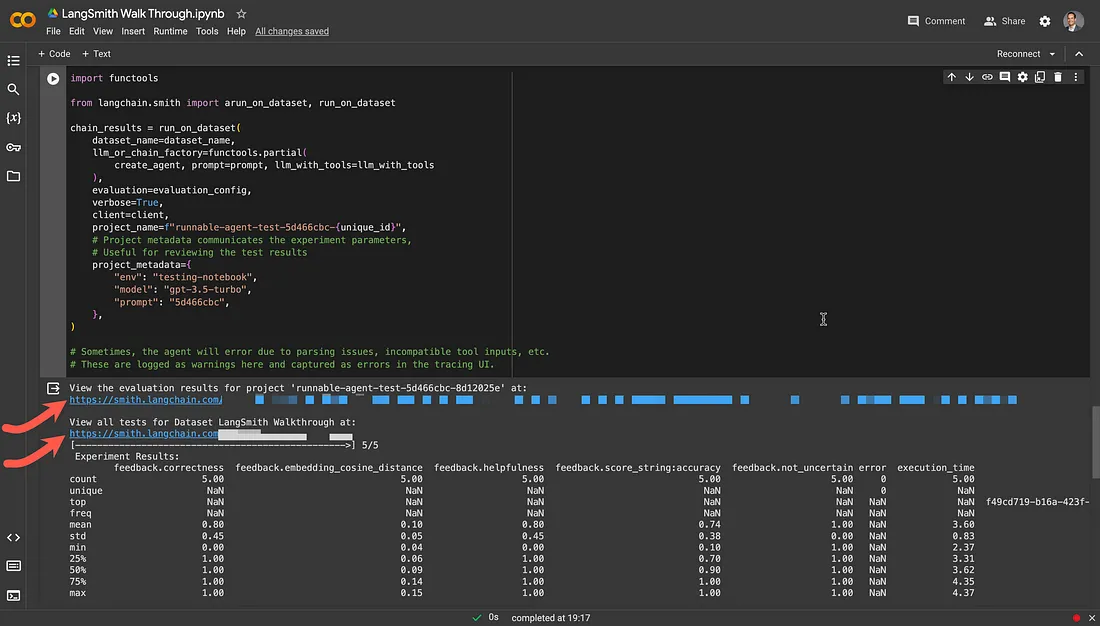深入剖析LangSmith: 评估由LangChain开发的三大核心组件
简介
我非常喜欢笔记本与 LangSmith 图形用户界面无缝集成的方式。通过代码执行任务,并通过网络图形用户界面查看结果。
应用程序可在项目下分类,提示可通过提示中心访问。数据集和测试可保存数据,并与代理运行相关联。
LangChain 在很大程度上实现了基于 LLM 的生成式应用开发的民主化。
使用 LangChain 进行原型开发是一回事,但将应用推向生产则是另一回事。
LangSmith 是 LangChain 的配套技术,可协助实现可观察性、可检查性、测试和持续改进。
在运行自主代理时,LangSmith 尤其有用,它能显示代理序列中的不同步骤或链条。此外,当向 LLM 发送多个并行请求时,LangSmith 也能提供帮助。
在本文中,我只考虑了 LangSmith 五个工具中的三个:项目、数据集与测试和集线器。
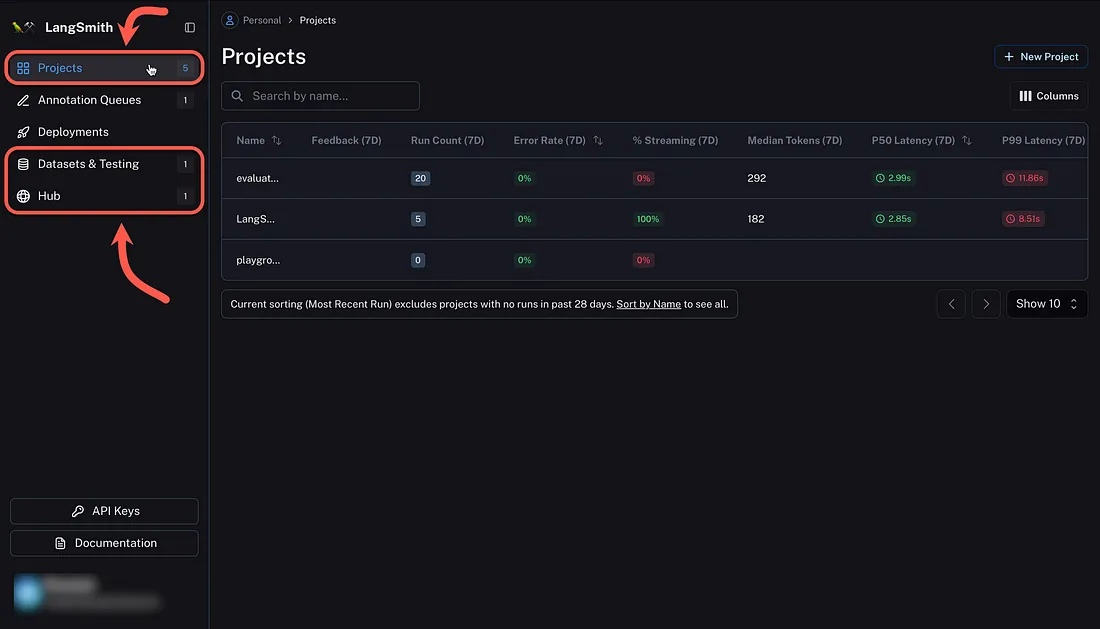
记录跟踪时运行代理
每当在 LangSmith 中创建一个新项目时,设置选项卡下都会显示代码片段,可将其包含在代码中,以便引用并将跟踪记录到 LangSmith 项目中。
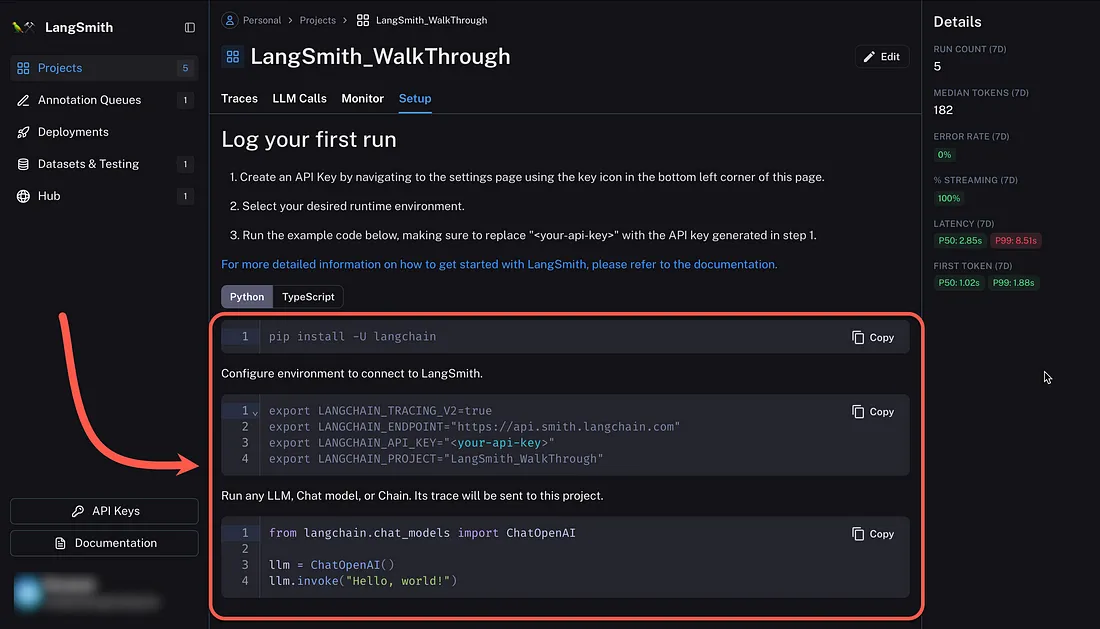
下面是安装 LangChain 所需组件的 Python 代码。请注意环境变量的设置。你可以在 Colab 笔记本中完全运行此应用程序。
%pip install --upgrade --quiet langchain langsmith langchainhub --quiet
%pip install --upgrade --quiet langchain-openai tiktoken pandas duckduckgo-search --quiet
import os
from uuid import uuid4
unique_id = uuid4().hex[0:8]
os.environ["LANGCHAIN_TRACING_V2"] = "true"
os.environ["LANGCHAIN_PROJECT"] = f"LangSmith_WalkThrough"
os.environ["LANGCHAIN_ENDPOINT"] = "https://api.smith.langchain.com"
os.environ["LANGCHAIN_API_KEY"] = "<Your LangSmith API Key>" # Update to your API key
# Used by the agent in this tutorial
os.environ["OPENAI_API_KEY"] = "<Your OpenAI API Key>"
定义代理
考虑到代理,请注意为该代理定义的唯一工具:
tools = [
DuckDuckGoSearchResults(
name="duck_duck_go"
), # General internet search using DuckDuckGo
]
该代理中心的提示通过下面的代码获取:
prompt = hub.pull("wfh/langsmith-agent-prompt:5d466cbc")并从提示中心检索提示:
input_variables=['agent_scratchpad', 'input']
input_types={'agent_scratchpad':
typing.List[typing.Union[langchain_core.messages.ai.AIMessage,
langchain_core.messages.human.HumanMessage,
langchain_core.messages.chat.ChatMessage,
langchain_core.messages.system.SystemMessage,
langchain_core.messages.function.FunctionMessage,
langchain_core.messages.tool.ToolMessage]]}
messages=[SystemMessagePromptTemplate(prompt=PromptTemplate(input_variables=[],
template='
You are an expert senior software engineer.
You are responsible for answering questions about LangChain.
Use functions to consult the documentation before answering.')),
HumanMessagePromptTemplate(prompt=PromptTemplate(input_variables=['input'],
template='{input}')), MessagesPlaceholder(variable_name='agent_scratchpad')]
运行代理的代码:
from langsmith import Client
client = Client()
from langchain import hub
from langchain.agents import AgentExecutor
from langchain.agents.format_scratchpad import format_to_openai_function_messages
from langchain.agents.output_parsers import OpenAIFunctionsAgentOutputParser
from langchain.tools import DuckDuckGoSearchResults
from langchain_community.tools.convert_to_openai import format_tool_to_openai_function
from langchain_openai import ChatOpenAI
# Fetches the latest version of this prompt
prompt = hub.pull("wfh/langsmith-agent-prompt:5d466cbc")
llm = ChatOpenAI(
model="gpt-3.5-turbo-16k",
temperature=0,
)
tools = [
DuckDuckGoSearchResults(
name="duck_duck_go"
), # General internet search using DuckDuckGo
]
llm_with_tools = llm.bind(functions=[format_tool_to_openai_function(t) for t in tools])
runnable_agent = (
{
"input": lambda x: x["input"],
"agent_scratchpad": lambda x: format_to_openai_function_messages(
x["intermediate_steps"]
),
}
| prompt
| llm_with_tools
| OpenAIFunctionsAgentOutputParser()
)
agent_executor = AgentExecutor(
agent=runnable_agent, tools=tools, handle_parsing_errors=True
)
inputs = [
"What is LangChain?",
"What's LangSmith?",
"When was Llama-v2 released?",
"What is the langsmith cookbook?",
"When did langchain first announce the hub?",
]
results = agent_executor.batch([{"input": x} for x in inputs], return_exceptions=True)
以及代理的输出:
[{'input': 'What is LangChain?',
'output': 'I\'m sorry, but I couldn\'t find any information about "LangChain". Could you please provide more context or clarify your question?'},
{'input': "What's LangSmith?",
'output': 'I\'m sorry, but I couldn\'t find any information about "LangSmith". It could be a company, a product, or a person. Can you provide more context or details about what you are referring to?'},
{'input': 'When was Llama-v2 released?',
'output': 'Llama-v2 was released on July 18, 2023.'},
{'input': 'What is the langsmith cookbook?',
'output': 'The Langsmith Cookbook is a collection of recipes and cooking techniques created by Langsmith, a fictional character. It is a comprehensive guide that covers a wide range of cuisines and dishes. The cookbook includes step-by-step instructions, ingredient lists, and tips for successful cooking. Whether you are a beginner or an experienced cook, the Langsmith Cookbook can help you enhance your culinary skills and create delicious meals.'},
{'input': 'When did langchain first announce the hub?',
'output': 'LangChain first announced the LangChain Hub on September 5, 2023.'}]很明显,代理的性能并不理想,因此可以使用 LangSmith 来评估和改进代理。
下图说明了可检查性;在该图中,可以检查代理的执行链。图中显示了来自 DuckDuckGo 集成的响应片段,该片段可作为提示的上下文学习。
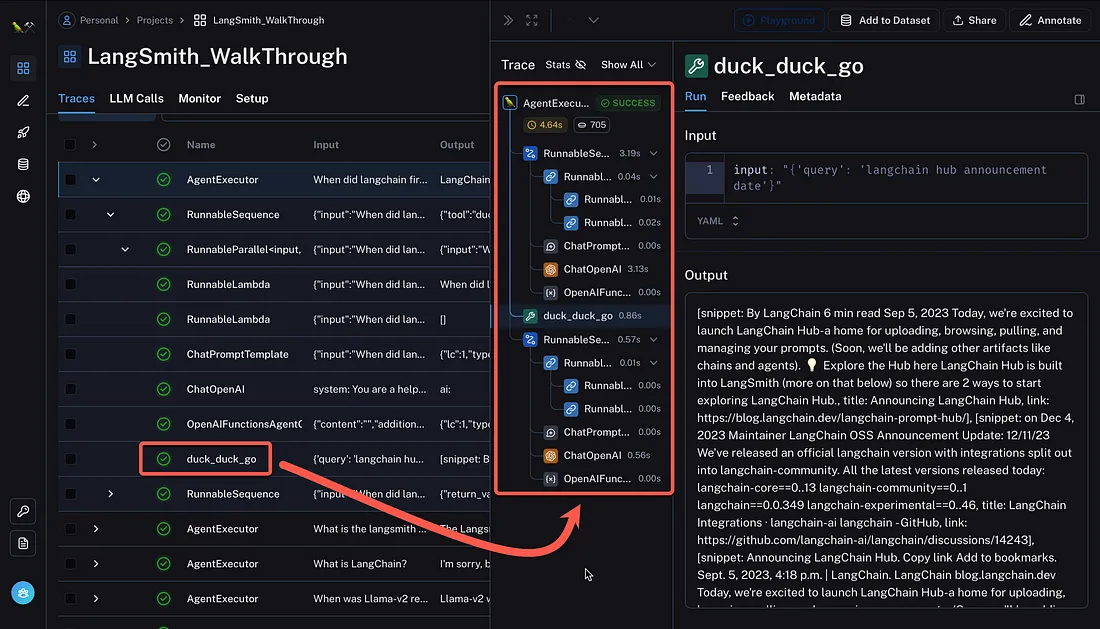
创建 LangSmith 数据集
下面显示了用于测试运行的五个输入和输出示例。这些条目将用于衡量新代理的性能。
数据集是示例的集合,只不过是输入输出对,你可以将其用作应用程序的测试用例。
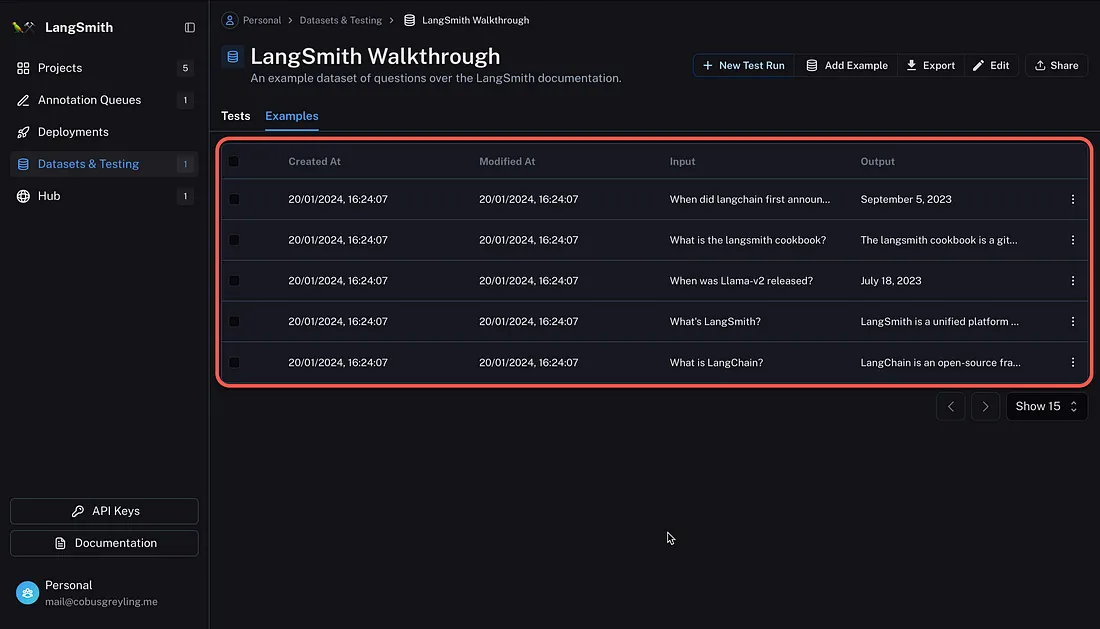
示例集的加载方式如下:
outputs = [
"LangChain is an open-source framework for building applications using large language models. It is also the name of the company building LangSmith.",
"LangSmith is a unified platform for debugging, testing, and monitoring language model applications and agents powered by LangChain",
"July 18, 2023",
"The langsmith cookbook is a github repository containing detailed examples of how to use LangSmith to debug, evaluate, and monitor large language model-powered applications.",
"September 5, 2023",
]
还有
dataset_name = f"LangSmith Walkthrough"
dataset = client.create_dataset(
dataset_name,
description="An example dataset of questions over the LangSmith documentation.",
)
client.create_examples(
inputs=[{"input": query} for query in inputs],
outputs=[{"output": answer} for answer in outputs],
dataset_id=dataset.id,
)
定义代理基准
下面将定义一个使用 OpenAI 函数调用端点的代理。
from langchain import hub
from langchain.agents import AgentExecutor, AgentType, initialize_agent, load_tools
from langchain.agents.format_scratchpad import format_to_openai_function_messages
from langchain.agents.output_parsers import OpenAIFunctionsAgentOutputParser
from langchain_community.tools.convert_to_openai import format_tool_to_openai_function
from langchain_openai import ChatOpenAI
# Since chains can be stateful (e.g. they can have memory), we provide
# a way to initialize a new chain for each row in the dataset. This is done
# by passing in a factory function that returns a new chain for each row.
def create_agent(prompt, llm_with_tools):
runnable_agent = (
{
"input": lambda x: x["input"],
"agent_scratchpad": lambda x: format_to_openai_function_messages(
x["intermediate_steps"]
),
}
| prompt
| llm_with_tools
| OpenAIFunctionsAgentOutputParser()
)
return AgentExecutor(agent=runnable_agent, tools=tools, handle_parsing_errors=True)
配置评估
在用户界面中手动比较链的结果是有效的,但可能会很耗时。
自动使用指标和人工智能辅助反馈来评估代理性能更省时省力。
下面是创建自定义运行评估器的代码,可记录启发式评估。
from langsmith.evaluation import EvaluationResult, run_evaluator
from langsmith.schemas import Example, Run
@run_evaluator
def check_not_idk(run: Run, example: Example):
"""Illustration of a custom evaluator."""
agent_response = run.outputs["output"]
if "don't know" in agent_response or "not sure" in agent_response:
score = 0
else:
score = 1
# You can access the dataset labels in example.outputs[key]
# You can also access the model inputs in run.inputs[key]
return EvaluationResult(
key="not_uncertain",
score=score,
)
下面将定义自定义评估器,并将结果与地面实况标签进行比较。
使用嵌入距离等测量语义相似性。
from langchain.evaluation import EvaluatorType
from langchain.smith import RunEvalConfig
evaluation_config = RunEvalConfig(
# Evaluators can either be an evaluator type (e.g., "qa", "criteria", "embedding_distance", etc.) or a configuration for that evaluator
evaluators=[
# Measures whether a QA response is "Correct", based on a reference answer
# You can also select via the raw string "qa"
EvaluatorType.QA,
# Measure the embedding distance between the output and the reference answer
# Equivalent to: EvalConfig.EmbeddingDistance(embeddings=OpenAIEmbeddings())
EvaluatorType.EMBEDDING_DISTANCE,
# Grade whether the output satisfies the stated criteria.
# You can select a default one such as "helpfulness" or provide your own.
RunEvalConfig.LabeledCriteria("helpfulness"),
# The LabeledScoreString evaluator outputs a score on a scale from 1-10.
# You can use default criteria or write our own rubric
RunEvalConfig.LabeledScoreString(
{
"accuracy": """
Score 1: The answer is completely unrelated to the reference.
Score 3: The answer has minor relevance but does not align with the reference.
Score 5: The answer has moderate relevance but contains inaccuracies.
Score 7: The answer aligns with the reference but has minor errors or omissions.
Score 10: The answer is completely accurate and aligns perfectly with the reference."""
},
normalize_by=10,
),
],
# You can add custom StringEvaluator or RunEvaluator objects here as well, which will automatically be
# applied to each prediction. Check out the docs for examples.
custom_evaluators=[check_not_idk],
)
该提示是从 LangSmith 提示中心导入的:
from langchain import hub
# We will test this version of the prompt
prompt = hub.pull("wfh/langsmith-agent-prompt:798e7324")
print (prompt)
运行评估程序,从指定数据集中获取示例行。
在每个示例上运行代理,并将评估程序应用于生成的运行轨迹,同时自动生成反馈。
结果在 LangSmith 中可见。
import functools
from langchain.smith import arun_on_dataset, run_on_dataset
chain_results = run_on_dataset(
dataset_name=dataset_name,
llm_or_chain_factory=functools.partial(
create_agent, prompt=prompt, llm_with_tools=llm_with_tools
),
evaluation=evaluation_config,
verbose=True,
client=client,
project_name=f"runnable-agent-test-5d466cbc-{unique_id}",
# Project metadata communicates the experiment parameters,
# Useful for reviewing the test results
project_metadata={
"env": "testing-notebook",
"model": "gpt-3.5-turbo",
"prompt": "5d466cbc",
},
)
# Sometimes, the agent will error due to parsing issues, incompatible tool inputs, etc.
# These are logged as warnings here and captured as errors in the tracing UI.
在 LangSmith 中,可以查看输入、示例参考输出和测试结果。
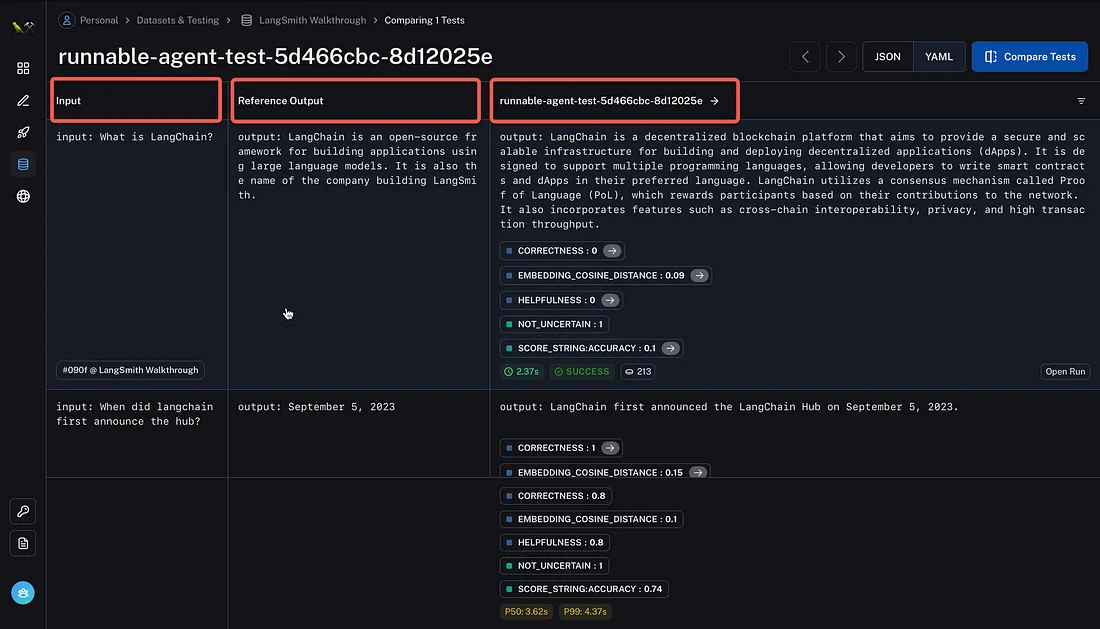
可检查性
请注意,在下图中,当在笔记本中运行评估时,会创建链接。第一个链接允许查看评估结果,也可以查看数据集的所有测试。
